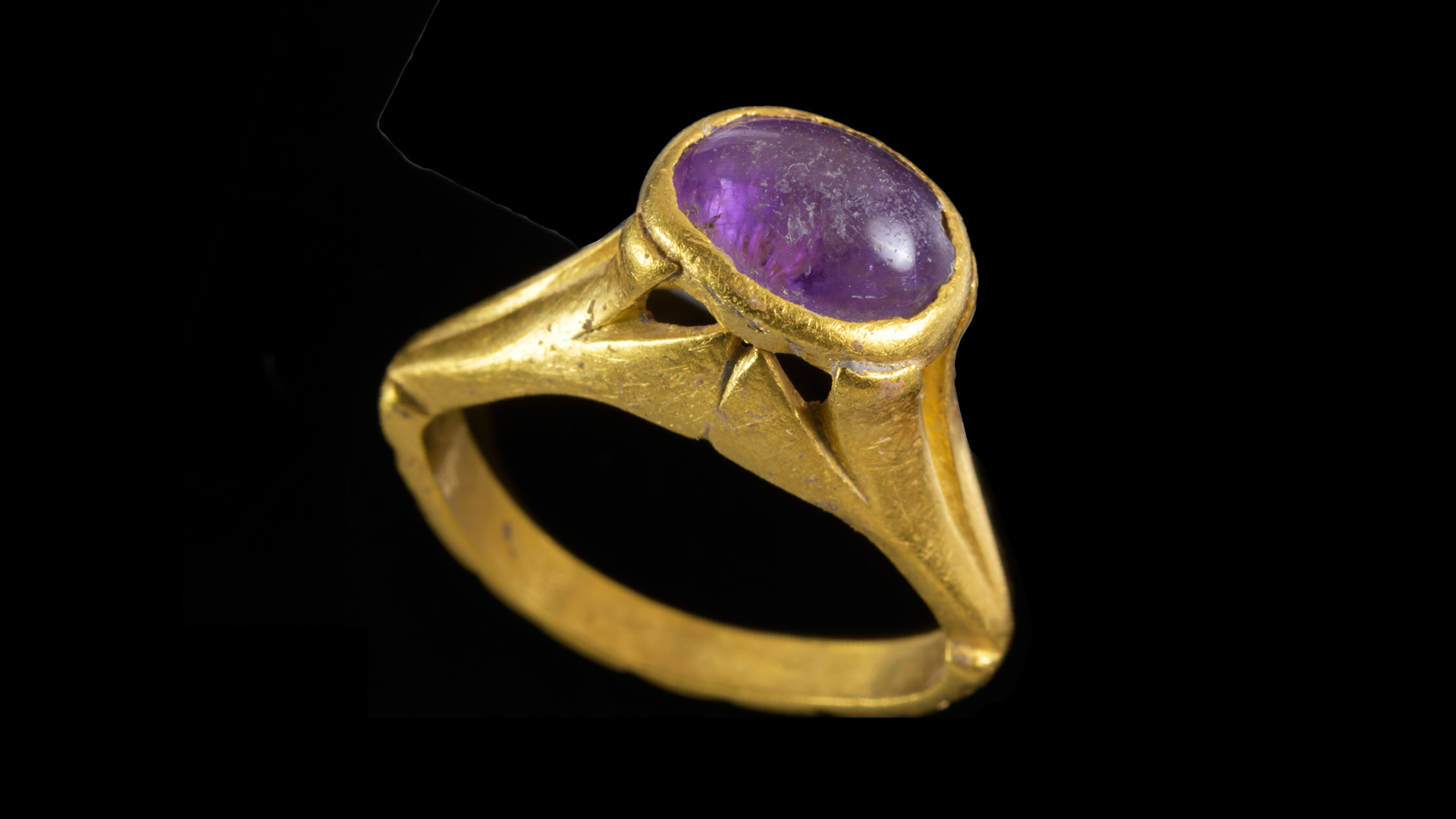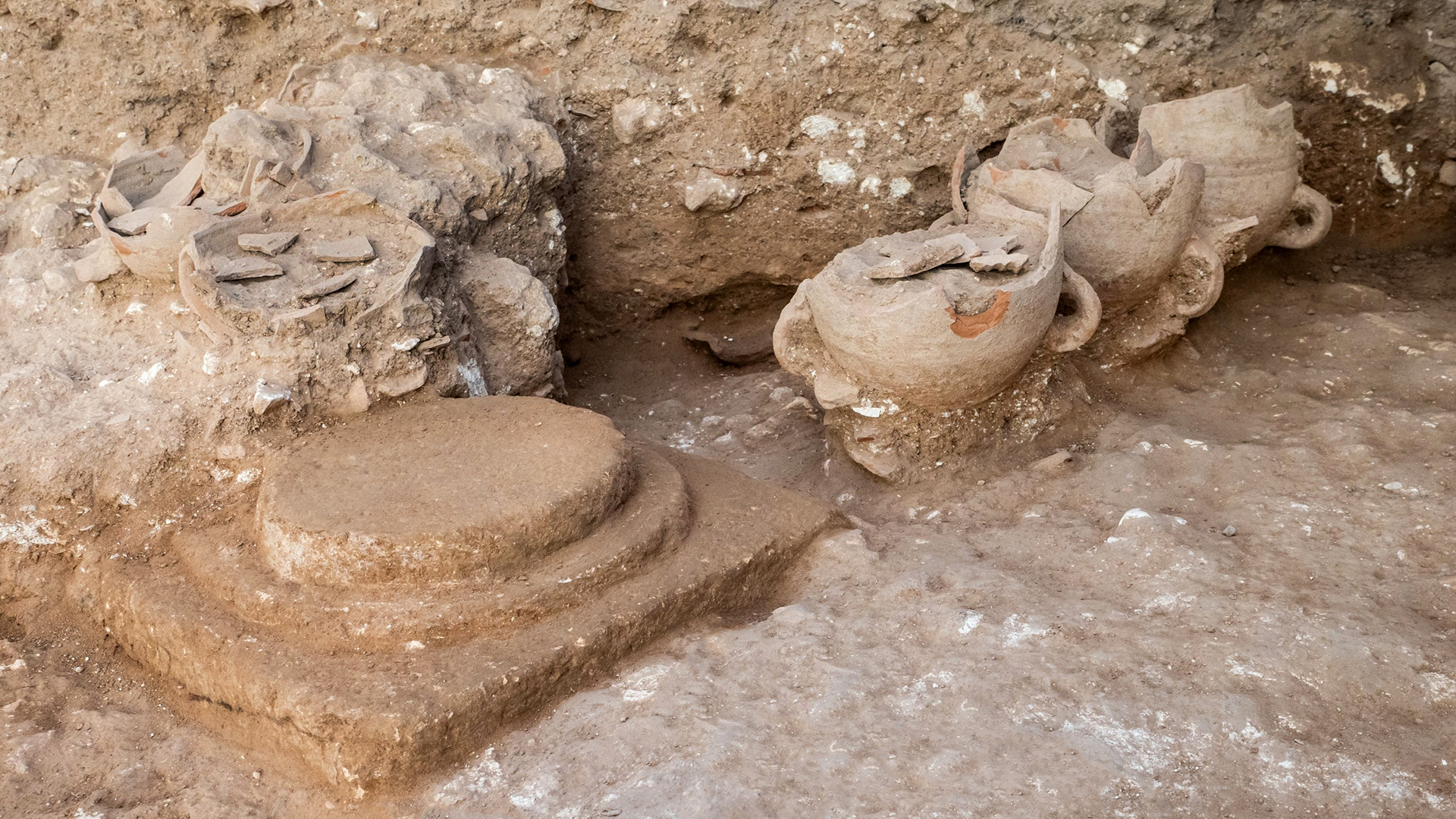Ancient 'hangover prevention' ring found in Israel
It's pretty and practical.

A gold ring found in the ruins of an ancient wine factory may have been worn more than 1,000 years ago for its beauty — or to ward off a hangover.
Archaeologists recently discovered the ring in Yavne, Israel, during the excavation of a site dating to Byzantine times (around A.D. 330 to 1453), where a massive wine factory once dominated the landscape. The factory is thought to have been the biggest producer of commercial wine during this period, exporting a high-quality vintage across ancient Israel and beyond, representatives of the Israel Antiquities Authority (IAA) wrote on Facebook.
However, a recent find at the site has little to do with the production or enjoyment of a crisp glass of wine, perhaps serving instead as protection against the painful aftermath that comes from drinking too much. The ring holds a purple stone that is likely an amethyst, and people in the region believed that such semiprecious gems were capable of preventing the discomfort of a hangover, IAA representatives said in a statement.
Related: The 25 most mysterious archaeological finds on Earth
"Amethysts are mentioned in [the] Bible as one of the 12 precious stones worn by the high priest of the Temple on his ceremonial breastplate," said Amir Golani, an IAA expert on ancient jewelry and one of the scientists who examined the ring. "Many virtues have been attached to this gem, including the prevention of the side effect of drinking — the hangover," Golani said in the statement.
That notion dates at least to the time of ancient Greece; the word "amethyst" comes from the Greek "amethystos," which means "not drunk," according to the Gemological Institute of America (GIA). Amethyst is a type of quartz that was once as prized as emeralds and rubies, until the 19th-century discovery of large deposits in Brazil made the gem cheaper and more widely accessible, the GIA said.

The Yavne wine factory, where this ring was found, pressed and bottled a type of white wine known as "Gaza wine" or "Ashkelon wine," so named for the ports where it departed for buyers in Europe and Asia, IAA representatives wrote in the statement on Facebook. Thousands of earthen jars — broken and intact — and other equipment in the ruins hinted at the massive scale of this ancient winemaking operation, which may have produced more than 500,000 gallons (2 million liters) of wine each year, according to the Facebook post.
Sign up for the Live Science daily newsletter now
Get the world’s most fascinating discoveries delivered straight to your inbox.
Researchers found the ring in a location dating to around the seventh century, near a warehouse for empty wine jar storage. Analysis of the ring's stone revealed that it was not a glass bauble. It was made of silica — a mineral found in gemstones — and its distinctive purple color hinted that the gem was an amethyst, according to the statement. Such a ring would have been worn by a wealthy person of high status, and could have adorned the finger of a man or a woman, Golani said.
Though the ring was buried during the seventh century, gold rings set with amethysts were popular among Roman elites as early as the third century, and the ring could have been made centuries before it was lost and then passed from hand to hand over generations, the researchers said.
Wearing the ring for hangover prevention is one interpretation; it's possible that the ring's owner placed it on their finger in hopes that they could then drink to excess without becoming drunk, Elie Haddad, director of the excavation on behalf of the IAA, suggested in the statement. Or perhaps the ring's owner simply wore it as a symbol of their wealth and prestige. But even though artifacts such as this can tell experts much about certain aspects of the distant past, many of the accompanying details have been lost to time.
"Did the person who wore the ring want to avoid intoxication due to drinking a lot of wine?" Haddad asked. "We probably will never know."
Originally published on Live Science.

Mindy Weisberger is an editor at Scholastic and a former Live Science channel editor and senior writer. She has reported on general science, covering climate change, paleontology, biology and space. Mindy studied film at Columbia University; prior to Live Science she produced, wrote and directed media for the American Museum of Natural History in New York City. Her videos about dinosaurs, astrophysics, biodiversity and evolution appear in museums and science centers worldwide, earning awards such as the CINE Golden Eagle and the Communicator Award of Excellence. Her writing has also appeared in Scientific American, The Washington Post and How It Works Magazine. Her book "Rise of the Zombie Bugs: The Surprising Science of Parasitic Mind Control" will be published in spring 2025 by Johns Hopkins University Press.









